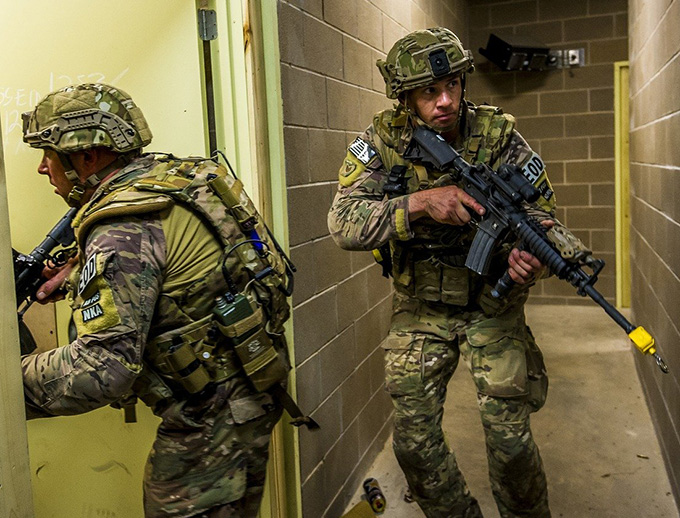
Guest OpEd by Ari Vidali, Founder & CEO, Envisage Technologies
Military training oversight has never been easy.
Every day poses challenges big and small, but there are specific actions leadership can adopt to make the process easier for all involved.
Training Challenges
The military’s role is multifaceted, and consequently blended learning is commonplace on many training levels.
Today’s military has many moving parts designed for different purposes. Many of those functions require hands-on training in a specialized environment, while others are better suited for in-person or online training.
For example, mastering hand-to-hand combat or training to clear a building of hostiles in a simulated urban setting requires a different training environment than learning how to pilot a reconnaissance drone or monitor an enemy’s communications.

Regardless of the mission, honing the necessary skills requires hours of instruction, repetition and monitoring.
Another challenge for military administrators is certain skill sets require in-person monitoring during training and simulations, while instruction and certification for other roles can be conducted in a traditional classroom or online forum.
Also, which personnel go to what training?
Rank or role, previous training history, specialization, seniority and countless other factors can complicate instruction variables to the point that M*A*S*H’s Radar O’Reilly would have trouble keeping the record keeping straight and accessible.
We haven’t even mentioned the multiple factors involved in new recruit training.
Military recruit training involves thousands of participants and requires massive internal coordination, with all participants requiring training, assessments and evaluation on their physical conditioning, skill set, qualifications and aptitude in a variety of diverse ways.
New recruit training and veteran training requires synchronized planning, scheduling, resourcing and student tracking.
This presents a two-pronged challenge: assigning and monitoring the efforts of multiple people at different places and times, and the difficult tasks administrators encounter when the tracking of student metrics is divided between fragmented data filing systems, or when analog storage is used rather than digital.
Conversely there are smart management digital systems available that address the military’s blended learning needs involving new recruits and veteran personnel, the unique training requirements for both, and the necessary administrative processes that help eliminate inefficiencies, duplicative efforts and communication snafus.
Automated Scheduling
Scheduling is a vital function of any training program and it affects operations processes ranging from attendance-taking to zero-hour certification deadlines.

Traditional scheduling tools involve paper, whiteboards and spreadsheets, yet any military administrator will attest to the logistical shortcomings and pitfalls involved with those conventional materials.
On the other hand, smart solutions like modular software suites enhance efficiency standards by integrating critical factors and processes that affect scheduling like the number of students per class, the length of time needed to complete a course, the number of students waiting to take the course, those completing it, the average passing grade, etc.
When scheduling data is entered in real-time and provides automated updates, this strengthens internal and external communications, eliminates confusion and uncertainty and helps improve both short-term planning and long-term forecasting.
Ensuring Readiness with a Synthesized System
A customized training ecosystem can create a useful synergy between traditionally disparate department functions like recruiting and training.
When done correctly, the processes employed by both are fully integrated, measurable and can be easily shared between departments.
For example, recruiters can use training metrics to pinpoint locations where students thriving in certain specialties were discovered and gauge the best talent pools for specific occupational recruiting needs.
Such an approach eliminates guesswork, creates marketing efficiencies, and over time can help forecast attrition averages, deployment numbers and training performance assessments.
The above example would only work if the recruiting and training departments synchronized their operational processes, but it’s certainly worth the effort due to the potential benefits.
Naturally leadership would have to sign off on such an ambitious effort and it’s important to start small. Every journey begins with a single step.
Adopting effective technology solutions to make military training leaner and smarter should involve a methodical rollout on a school by school basis.
Starting small enables participants to perfect the process by carefully evaluating lessons learned on a step by step basis, refining and tweaking along the way.
It’s only then administrators should build on the foundation of the first successful implementation and expand to the next school.
Anticipate, Implement, Adapt
To avoid a fundamental erosion in military readiness, it’s imperative to avoid a fragmented approach to training and employ a strategic system that anticipates operational needs, is easy to implement and is adaptable to change.
It should improve efficiency, enhance communication and transparency, and feature successful technology monitoring.
About the Author
Ari Vidali is Founder & CEO of Envisage Technologies, creators of the Acadis Readiness Suite, a comprehensive, modular training management framework that modernizes and streamlines the complex operations of nearly 11,000 public safety agencies, serving over 2 million first responders via their FirstForward online training network.
















